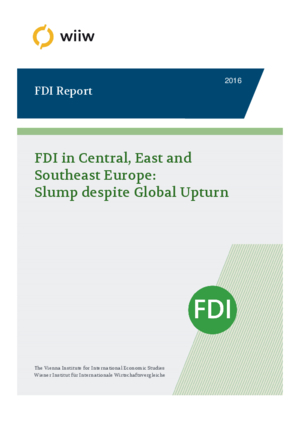Slump despite Global Upturn
Gabor Hunya and Monika Schwarzhappel
wiiw FDI Report No. 2016-06, June 2016
149 pages including 105 Tables, 10 Figures and 5 Boxes
Content and General Description (PDF)
In 2015, the FDI inflow to the Central, East and Southeast European (CESEE) countries fell to its lowest level since 2008, while global FDI recovered. The decline was especially severe in the EU Member States of Central and Eastern Europe, as well as in Russia, while expansions were recorded in the Western Balkans and Turkey. The first part of this report provides an analysis of the 2015 FDI trends in 23 countries, highlighting uneven developments.
New features of FDI have appeared recently in the Central European countries, which are deeply integrated into multinational production networks. FDI inflows fluctuate more wildly than before and have lost their close connection with economic growth or changes in the business environment. Capital relations between subsidiaries and parent companies have become more complex: capital reserves, losses and profits are shifted around within multinational conglomerates in various forms of FDI and income. Moreover, tax optimisation by multinational enterprises has become one of the main factors determining the economic sector or the immediate host country chosen by investors when they reorganise their assets into holdings. Round-tripping domestic capital distorts the FDI statistics, of Russia in particular.
Special sections of this report analyse the Russian FDI collapse, the Chinese expansion, and the position of Austria as investor and investment destination of CESEE countries. A further section presents new features of greenfield investments in 2015: a declining number of projects and lower capital investments that increasingly focus on the manufacturing sector. Forecasts for FDI in 2016 point downwards again, because the international environment may not support capacity expansions, and also economic growth in most of the CESEE will be less robust than last year.
The second part of this report contains two sets of tables: Tables I cover FDI flow and stock data, FDI flows by components and related income; Tables II provide detailed FDI data by economic activity and by country. The main sources of data are the central banks of the individual Central, East and Southeast European countries. Methodological explanations highlight important recent changes in reporting standards and their application in the wiiw FDI Database and wiiw FDI Report.
The wiiw FDI Database is available online
This online access with a modern query tool supports easy search and download of data.
The wiiw FDI Database contains the full set of FDI data with time series starting form 1990 as far as available.
Access to wiiw FDI Database
Reference to wiiw databases: wiiw Annual Database, wiiw FDI Database
Keywords: foreign direct investment, balance of payments, FDI by form, income repatriation, statistics, new EU Member States, Central Europe, Southeast Europe, Western Balkans, China, Turkey, CIS, Russia, Ukraine
JEL classification: C82, F21, O57, P23
Countries covered: Albania, Belarus, Bosnia and Herzegovina, Bulgaria, CIS, Croatia, Czechia, Estonia, Hungary, Kazakhstan, Kosovo, Latvia, Lithuania, North Macedonia, Moldova, Montenegro, New EU Member States, Poland, Romania, Russia, SEE, Serbia, Slovakia, Slovenia, Turkey, Ukraine
Research Areas: International Trade, Competitiveness and FDI
ISBN-13: 978-3-85209-050-4
Press Releases
Related Presentations
- Slump despite Global Upturn (press conference presentation in English)
- Slump despite Global Upturn (press conference presentation in German)
